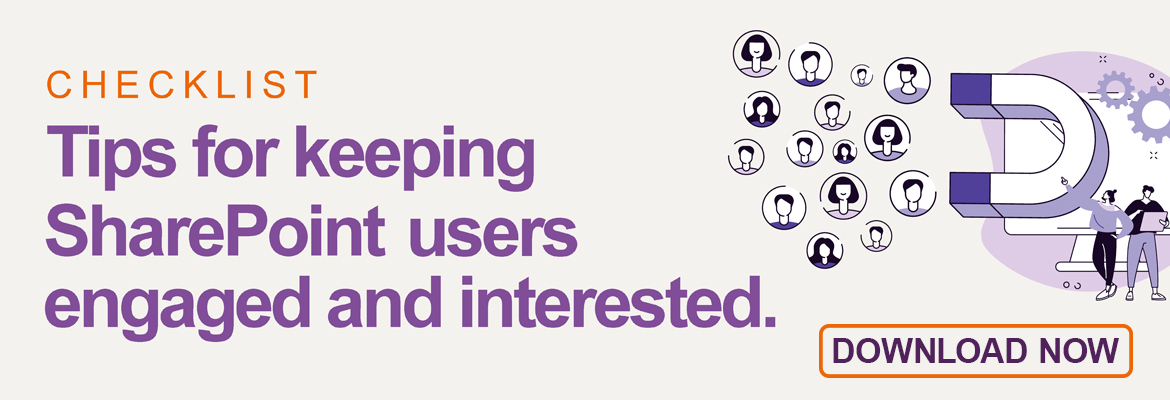Many intranet projects introduce too many drastic changes quickly. With so many new places to find and store information, new tools and devices to learn, and new processes to make it all work, it’s easy to see why it can be overwhelming for some. In an infographic here about the lessons we have learned from deploying intranets successfully, we have noted that involving your end users at the onset is critical for ensuring your intranet’s success.
In this blog post, we explain how you can win over your users and communicate the value of your intranet from day one. Here are tips on how to ensure commitment to your intranet remains high from pre-launch through to the longer term.
Tips for keeping users engaged and interested
A user engagement strategy can provide a focus before, during and after launch activities. A well-developed plan can drive adoption and help ensure a sustained return on investment.
Try building these ideas into your strategy to sustain user interest in your new initiative:
- Customise your adoption campaigns so they resonate with the different work areas to help drive adoption
- Consider competitions and incentive programs linked to longer term KPIs to help sustain the changes
- Ensure your intranet remains up to date and relevant to continually drive and foster adoption. Try regular news and communications events, social interactions or engagement activities such as classifieds or team photos to keep people interested.
- Select a simple interface where users can find what they are looking for quickly and easily
- Make the tools that people need prominent. Keep news feeds and social tools in a prominent place
- Show users how the new solution creates efficiencies by streamlining and automating key business processes
- Share the user adoption analytics or other measurements of success
- Highlight teams that may need additional support by running surveys, polls or feedback sessions.
 DOWNLOAD CHECKLIST: Tips for keeping your SharePoint Intranet Users Engaged.
DOWNLOAD CHECKLIST: Tips for keeping your SharePoint Intranet Users Engaged.
Don’t make change management an afterthought
Poor change management can result in low user adoption and employees who don’t know how to use the solution. Make sure you’ve planned how to manage change well ahead of launch.
Once the new system is live, users will need to move to a new way of doing things. Before this happens, it’s important for you to understand what behaviour changes are needed for users to make the shift so that you can support them to change their behaviour.
Remember that unless they make a conscious decision to engage and become an active user, you won’t see the full benefits that a successful intranet can provide.
In preparing for the launch, users will need assistance to develop their skills so that they are ready to hit the ground running once the system goes live.
Some things to remember:
- Drive user adoption by ensuring you have a change strategy in place, and that users know what the phases of change will be.
- Start change processes early in the implementation, well before the new solution has gone live.
- Provide a combination of initiatives to help embed the changes. These may include face-to-face training sessions, quick reference guides or interactive workshops.
You may also want to consider removing barriers to user adoption that make it easy for users to continue doing things the old way. For example, making file shares read-only a month after launch will stop the old process.
Breaking the cycle encourages users to embrace the new way of doing things and will help reinforce the change, particularly for those who may be resistant to leaving what they know behind.
How to measure success
It’s important to define what success will look like and set some key change objectives that you can measure against over time to track your progress. Look forward six months after go-live. What needs to have changed in the way your teams work today for you to be realising the benefits?
While it’s important to measure the rate of user adoption at go live, setting regular follow-up activities to measure how user adoption is tracking allows you to identify trends early. If adoption rates fall, you’ll then be able to respond quickly with follow-up activities such as extra training or support.
Staying on track
User engagement and adoption are ongoing processes. If the solution doesn’t meet the needs of users, they may start to use workarounds and revert to old processes. Remove the ability for them to continue with their old ways.
To stay on track, you can:
- actively seek key user experience feedback through conversations or surveys as well as hard data and analytics such as page hits
- establish ongoing plans for user adoption to shape user experiences and perceptions of the system
- continue to consider the wants and needs of users but avoid making assumptions
- keep content fresh and dynamic by assigning ownership of it to particular user groups.
Remembering the three Ps – people, planning and promotion – will ensure your project stays on track and your investment delivers results.






